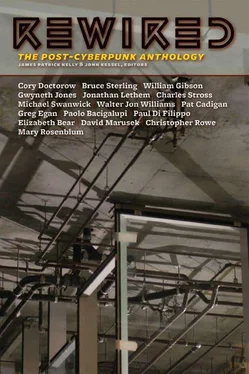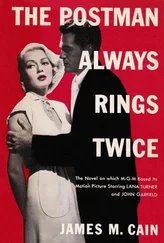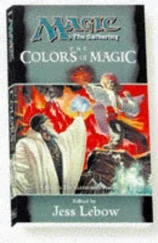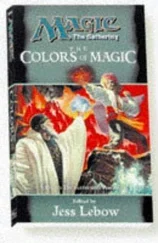“Okay, granted, I’m a little late,” replied Dumont fruitily. “But you did promise after the Woodies that you’d come with me to hang out with my pals.”
As this warped yet still meaningful dialogue from his personal life began to resonate with Bash, he started to feel queasy. He laid the newspaper nearly flat on the breakfast table, right atop his plate of auk eggs and fried plantains with mango syrup, and as the crease separating the half-pages disappeared, the movie redrew itself to fill the whole expanse of one side.
Groucho struck a mocking pose, one hand cradling his chin, the other with cigar poised at his brow. “Well, a self-important louse like me can’t be bothered with that bunch of crazy amateur artistes you hang out with. Such crazy ideas! So I’ve decided to abandon you and return to my cloistered sterile existence.”
“Hit the road, then, you jerk! But I’ll have the last laugh! You just wait and see!”
With that parting sally, Dumont and Marx vanished from Bash’s newspaper. But the words and images that comprised Bash’s regular morning bluetoothed installment of The Boston Globe did not reappear. The sheet of proteopape remained a frustrating virginal white, unresponsive to any commands Bash gave it.
After his frustrated attempts to regain control of the newspaper, Bash gave up, reluctantly conceding that this sheet of proteopape was dead. He slumped back in his chair with a nervous sigh, admitting to himself that the origin of this sabotage was all too evident.
Why, oh why had he ever agreed to a date with Dagny Winsome?
York and Adelaide Applebrook had gone bust in the big dotcom crash that had inaugurated the twenty-first century. Their entrepreneurial venture — into which they had sunk their own lifesavings and millions of dollars more from various friends, relatives and venture capitalists — had consisted of a website devoted to the marketing of Japanese poetry. Behind the tasteful interactive facade of Haiku Howdy! had been nothing more than a bank of public domain images — Oriental landscapes, for the most part — and a simplistic poetry generator. The visitor to Haiku Howdy! would input a selection of nouns and adjectives that the software would form into a haiku. Matched with an appropriate image, the poem could be emailed to a designated recipient. Initially offered as a free service, the site was projected to go to pay-per-use status in a year or two, with estimated revenues often million dollars a year.
This rudimentary site and whimsical service represented the grand sum of the Applebrooks’ inspiration and marketing plan.
The fact that at the height of their “success,” in the year 1999, they named their newborn son Basho, after the famous master of haiku, was just one more token of their supreme confidence in their scheme.
When Haiku Howdy! collapsed after sixteen months of existence, having burned through millions and millions of dollars of OPM, the Applebrooks had cause to rethink their lifestyle and goals. They moved from Seattle to the less pricey rural environs of Medford, Oregon, and purchased a small pear orchard with some leftover funds they had secretly squirreled away from the screamingly burned investors. They took a vow then and there to have nothing further to do with any hypothetical future digital Utopia, making a back-to-the-land commitment similar to that made by many burnt-out hippies a generation prior.
Surely the repentant, simple-living Applebrooks never reckoned that their only child, young Basho, would grow up to revolutionize, unify and dominate the essential ways in which digital information was disseminated across all media.
But from his earliest years Bash exhibited a fascination with computers and their contents. Perhaps his prenatal immersion in the heady dotcom world had imprinted him with the romance of bytes and bauds. In any case, Bash’s native talents (which were considerable; he tested off the high end of several scales) were, from the first, bent toward a career in information technologies.
Bash zipped through public schools, skipping several grades, and enrolled at MIT at age fifteen. Socially, Basho Applebrook felt awkward amidst the sophisticated elders of his generation. But in the classroom and labs he excelled. During his senior year on campus he encountered his most important success in the field of moletronics, the science of manipulating addressable molecules, when he managed to produce the first fully functional sheet of proteopape.
Alone late one night in a lab, Bash dipped a standard blank sheet of high quality dumb-paper into a special bath where it absorbed a tailored mix of dopant molecules. (This bath was the four hundred and thirteenth reformulation of his original recipe.) Removing the paper, Bash placed it in a second tub of liquid. This tub featured a lattice of STM tweezers obedient to computer control. Bash sent a large file into the tub’s controllers, and, gripping hold of each doped molecule with invisible force pincers, the device laid down intricate circuitry templates into the very molecules of the paper.
Junctions bloomed, MEMS proliferated. Memory, processors, sensors, a GPS unit, solar cells, rechargeable batteries, speakers, pixels, a camera and wireless modem: all arrayed themselves invisibly and microscopically throughout the sheet of paper.
Removing the paper from its complexifying wash, Bash was pleased to see on its glistening face a hi-res image. Depicted was a small pond with a frog by its edge, and the following haiku by Bash’s namesake:
Old pond
Frog jumps in
Splash!
Bash tapped a control square in the corner of the display, and the image became animated, with the frog carrying out the poem’s instructions in an endless loop, with appropriate soundtrack.
Bash’s smile, observed by no one, lit up the rafters.
Thus was born “protean paper,” or, as a web-journalist (nowadays remembered for nothing else but this coinage) later dubbed it, “proteopape.”
Bash’s miraculous process added merely hundredths of a cent to each piece of paper processed. For this token price, one ended up with a sheet of proteopape that possessed magnitudes more processing power than an old-line supercomputer.
In effect, Bash had created flexible, weightless computers practically too cheap to sell.
But the difference between “practically” and “absolutely” meant a lot, across millions of units.
I 2— the age of Immanent Information — was about to commence.
A visit to the same canny lawyer who had helped his parents survive bankruptcy nearly twenty years earlier insured that Bash’s invention was securely patented. Anyone who wanted to employ Bash’s process would have to license it from him, for a considerable annual fee.
At this point, the nineteen-year-old Bash went public.
By the time he was twenty-one, he was the richest man in the world.
But he had still never even ventured out on a date with any member of the opposite sex who was not his cousin Cora on his mother’s side.
Dagny Winsome resembled no one so much as a pale blonde Olive Oyl. Affecting retro eyeglasses in place of the universal redactive surgery to correct her nearsightedness, Dagny exhibited a somatotype that evoked thoughts of broomsticks, birches, baguettes and, given her predilection for striped shirts, barber poles. But her lack of curvature belied a certain popularity with males, attributable to her quick wit, wild impulsiveness and gleeful subversiveness. Her long pale hair framed a face that could segue from calm innocence to irate impatience to quirky amusement in the span of a short conversation. Dagny’s four years at MIT had been marked by participation in a score of famous hacks, including the overnight building of a two-thirds mockup of the Space Shuttle George W. Bush resting in a simulated crash in the middle of Massachusetts Avenue.
Читать дальше












